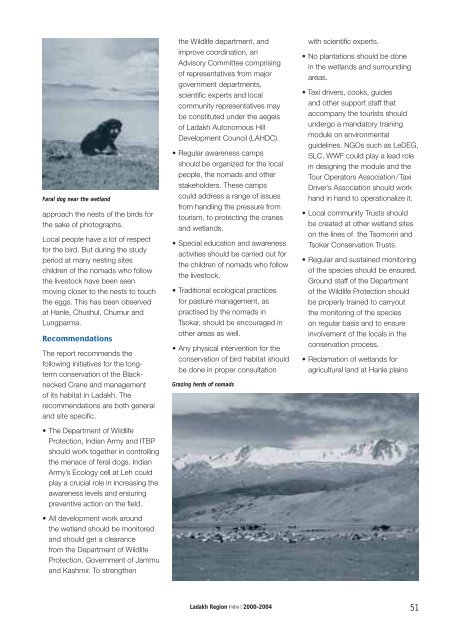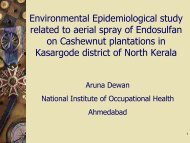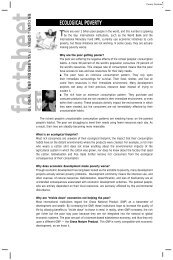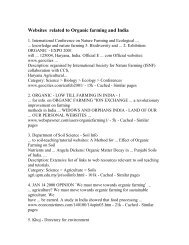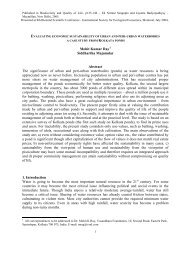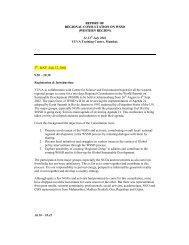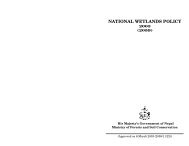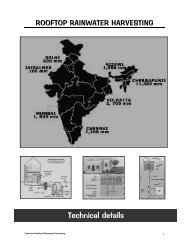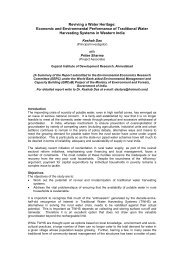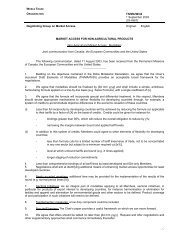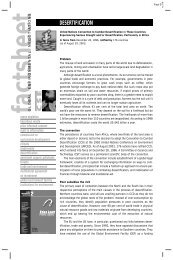Black-necked Crane - WWF-India
Black-necked Crane - WWF-India
Black-necked Crane - WWF-India
You also want an ePaper? Increase the reach of your titles
YUMPU automatically turns print PDFs into web optimized ePapers that Google loves.
Faral dog near the wetland<br />
approach the nests of the birds for<br />
the sake of photographs.<br />
Local people have a lot of respect<br />
for the bird. But during the study<br />
period at many nesting sites<br />
children of the nomads who follow<br />
the livestock have been seen<br />
moving closer to the nests to touch<br />
the eggs. This has been observed<br />
at Hanle, Chushul, Chumur and<br />
Lungparma.<br />
Recommendations<br />
The report recommends the<br />
following initiatives for the longterm<br />
conservation of the <strong>Black</strong><strong>necked</strong><br />
<strong>Crane</strong> and management<br />
of its habitat in Ladakh. The<br />
recommendations are both general<br />
and site specifi c.<br />
• The Department of Wildlife<br />
Protection, <strong>India</strong>n Army and ITBP<br />
should work together in controlling<br />
the menace of feral dogs. <strong>India</strong>n<br />
Army’s Ecology cell at Leh could<br />
play a crucial role in increasing the<br />
awareness levels and ensuring<br />
preventive action on the fi eld.<br />
• All development work around<br />
the wetland should be monitored<br />
and should get a clearance<br />
from the Department of Wildlife<br />
Protection, Government of Jammu<br />
and Kashmir. To strengthen<br />
the Wildlife department, and<br />
improve coordination, an<br />
Advisory Committee comprising<br />
of representatives from major<br />
government departments,<br />
scientifi c experts and local<br />
community representatives may<br />
be constituted under the aegeis<br />
of Ladakh Autonomous Hill<br />
Development Council (LAHDC).<br />
• Regular awareness camps<br />
should be organized for the local<br />
people, the nomads and other<br />
stakeholders. These camps<br />
could address a range of issues<br />
from handling the pressure from<br />
tourism, to protecting the cranes<br />
and wetlands.<br />
• Special education and awareness<br />
activities should be carried out for<br />
the children of nomads who follow<br />
the livestock.<br />
• Traditional ecological practices<br />
for pasture management, as<br />
practised by the nomads in<br />
Tsokar, should be encouraged in<br />
other areas as well.<br />
• Any physical intervention for the<br />
conservation of bird habitat should<br />
be done in proper consultation<br />
Grazing herds of nomads<br />
with scientifi c experts.<br />
• No plantations should be done<br />
in the wetlands and surrounding<br />
areas.<br />
• Taxi drivers, cooks, guides<br />
and other support staff that<br />
accompany the tourists should<br />
undergo a mandatory training<br />
module on environmental<br />
guidelines. NGOs such as LeDEG,<br />
SLC, <strong>WWF</strong> could play a lead role<br />
in designing the module and the<br />
Tour Operators Association/Taxi<br />
Driver’s Association should work<br />
hand in hand to operationalize it.<br />
• Local community Trusts should<br />
be created at other wetland sites<br />
on the lines of the Tsomoriri and<br />
Tsokar Conservation Trusts.<br />
• Regular and sustained monitoring<br />
of the species should be ensured.<br />
Ground staff of the Department<br />
of the Wildlife Protection should<br />
be properly trained to carryout<br />
the monitoring of the species<br />
on regular basis and to ensure<br />
involvement of the locals in the<br />
conservation process.<br />
• Reclamation of wetlands for<br />
agricultural land at Hanle plains<br />
Ladakh Region <strong>India</strong> | 2000-2004 51


